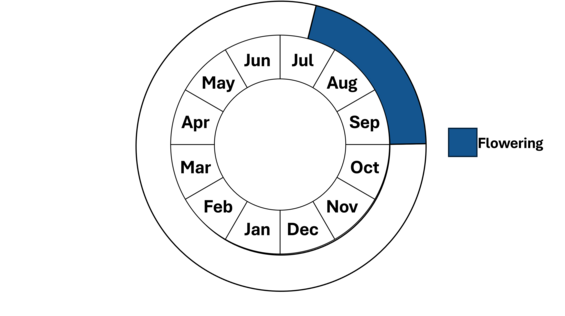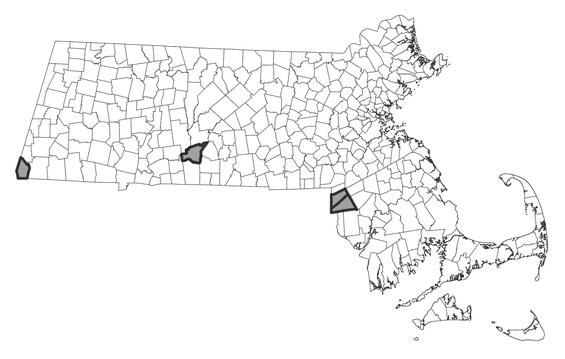- Scientific name: Ranunculus pensylvanicus
- Species of Greatest Conservation Need (MA State Wildlife Action Plan)
- Species of Special Concern (MA Endangered Species Act)
Description
Bristly buttercup (Ranunculus pensylvanicus), a member of the buttercup family (Ranunculaceae), is an annual or short-lived perennial herb with small, pale-yellow flowers, hairy stems, and alternate, divided leaves. It grows to a height of 30-70 cm (1-2.25 ft) and is found in a variety of habitats ranging from stream banks, marsh edges, bogs, moist clearings, and ditches, to wet woods. In Latin, the name Ranunculaceae comes from rana meaning “little frog,” referring to the wet habitats in which many species of the genus Ranunculus occur.
Bristly buttercup is distinguished from other buttercups by its leaves, hairy (pubescent) stem, flowers, and fruits. The toothed, alternate leaves are trifoliate, deeply cut into three sections or lobes. The middle leaf lobe is stalked (has a petiolule). The basal and stem leaves of bristly buttercup are similar in appearance, but the basal leaves tend to wither early in the growing season while the stem leaves persist throughout the summer. The erect stem is covered in short hairs and may be branching or not. The flowers are few, pale yellow, small (0.6-0.8 cm; 0.25-0.3 in) wide, borne on short stalks, and have five egg-shaped (obovate) petals. The fruits have short, stout appendages projecting from their tips. These appendages, called beaks, are straight to slightly curved, but not hooked, and form a cylindrical cluster that is 0.8-1.3 cm (0.3-0.5 in) long. Bristly buttercup may be incapable of spreading vegetatively, so the successful germination of its seeds and subsequent seedling establishment are imperative to its persistence.
Bristly buttercup is separable from other species in the genus Ranunculus by its small flowers and by the fact that the basal and stem leaves are both lobed. In Massachusetts, bristly buttercup is most likely to be confused with hooked buttercup (Ranunculus recurvatus). The two species are separable by their degree of pubescence, leaf shape, flowering time, and fruit. The bristly buttercup, as its name implies, has stems beset with bristly, stiff, and spreading hairs, while the hooked buttercup is only sparingly pubescent. Unlike bristly buttercup, the middle lobes of the leaves of hooked buttercup are not borne on a stalk (petiolule). Also, the leaves of hooked buttercup have more egg-shaped (obovate) lobes than the lobes of the more divided leaves of bristly buttercup. Hooked buttercup bloom earlier than bristly buttercup, flowering from April to June, while bristly buttercup flowers from mid-July to September. The fruits of hooked buttercup have a distinctly hooked or coiled beak, unlike the straight or slightly curved beak of bristly buttercup fruits.
Life cycle and behavior
This is an annual species.

Population status
Bristly buttercup is listed under the Massachusetts Endangered Species Act as a species of special concern. All listed species are legally protected from killing, collection, possession, or sale, and from activities that would destroy habitat and thus directly or indirectly cause mortality or disrupt critical behaviors. Bristly buttercup is currently known from Berkshire, Hampden, and Worcester counties.
Distribution and abundance
Bristly buttercup occurs in North America and eastern Asia. In North America, its range extends from Newfoundland west to Alaska, with the exception of the Yukon and Nunavut Territories, and south to Oregon, Illinois, and Maryland. There are also documented occurrences of it in Arizona and New Mexico. Bristly buttercup is rare in numerous states including Vermont, New Jersey, Delaware, and Pennsylvania, but it is not considered globally imperiled.

Habitat
A habitat generalist, bristly buttercup, grows in a variety of areas that tend to have open to filtered light and that are wet to periodically flooded. Bristly buttercup often inhabits areas with some disturbance. In Massachusetts, bristly buttercup has been documented in a range of habitats including marsh edges, vernal pools, seasonally flooded riverbanks, powerline rights of way through alluvial wetlands, wet swales, drawn-down glacial kettle-holes, shrub swamps, and the edges of or openings in floodplain forests. Various plants of wetlands and shores may be found growing in association with bristly buttercup in Massachusetts, including beggars-ticks (Bidens spp.), jewelweed (Impatiens capensis), water-horehounds (Lycopus spp.), false nettle (Boehmeria cylindrica), marsh fern (Thelypteris palustris), monkey flower (Mimulus ringens), and sensitive fern (Onoclea sensibilis).
Healthy habitats are vital for supporting native wildlife and plants. Explore habitats and learn about conservation and restoration in Massachusetts.
Threats
Bristly buttercup requires a wet to periodically inundated habitat. Activities that permanently alter hydrologic regimes, such as the building of dams, could be harmful to bristly buttercup. Many Massachusetts populations of bristly buttercup occur in transition areas where the edge of a marsh borders a cornfield or lawn. Mowing of these adjacent fields or lawns may be beneficial to bristly buttercup by maintaining sunny conditions but could be detrimental to the species if the mowers accidentally cut the plants, especially if cutting occurs before bristly buttercup sets seed. Invasive plants capable of forming dense monocultures in wetlands, such as purple loosestrife (Lythrum salicaria) and reed canary-grass (Phalaris arundinacea), may exclude bristly buttercup through over-shading.
Conservation
The natural hydrologic regime of habitats should be protected or restored as needed. Efforts should be made to prevent the dispersal of such invasive plants into areas where bristly buttercup grows. To avoid inadvertent harm to rare plants, all active management of rare plant populations (including invasive species removal) should be planned in consultation with the MassWildlife’s Natural Heritage & Endangered Species Program.
Contact
| Date published: | May 12, 2025 |
|---|